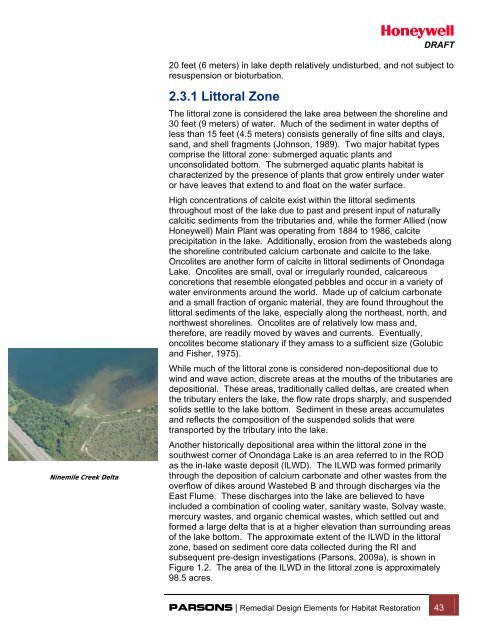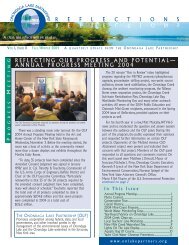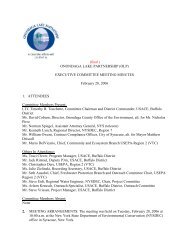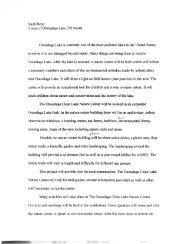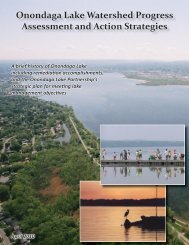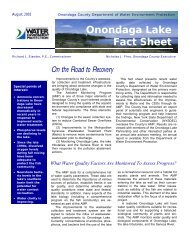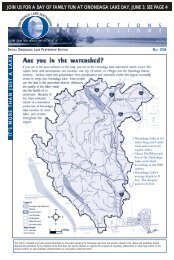Habitat Plan 2 - Onondaga Lake Partnership
Habitat Plan 2 - Onondaga Lake Partnership
Habitat Plan 2 - Onondaga Lake Partnership
Create successful ePaper yourself
Turn your PDF publications into a flip-book with our unique Google optimized e-Paper software.
DRAFT20 feet (6 meters) in lake depth relatively undisturbed, and not subject toresuspension or bioturbation.Ninemile Creek Delta2.3.1 Littoral ZoneThe littoral zone is considered the lake area between the shoreline and30 feet (9 meters) of water. Much of the sediment in water depths ofless than 15 feet (4.5 meters) consists generally of fine silts and clays,sand, and shell fragments (Johnson, 1989). Two major habitat typescomprise the littoral zone: submerged aquatic plants andunconsolidated bottom. The submerged aquatic plants habitat ischaracterized by the presence of plants that grow entirely under wateror have leaves that extend to and float on the water surface.High concentrations of calcite exist within the littoral sedimentsthroughout most of the lake due to past and present input of naturallycalcitic sediments from the tributaries and, while the former Allied (nowHoneywell) Main <strong>Plan</strong>t was operating from 1884 to 1986, calciteprecipitation in the lake. Additionally, erosion from the wastebeds alongthe shoreline contributed calcium carbonate and calcite to the lake.Oncolites are another form of calcite in littoral sediments of <strong>Onondaga</strong><strong>Lake</strong>. Oncolites are small, oval or irregularly rounded, calcareousconcretions that resemble elongated pebbles and occur in a variety ofwater environments around the world. Made up of calcium carbonateand a small fraction of organic material, they are found throughout thelittoral sediments of the lake, especially along the northeast, north, andnorthwest shorelines. Oncolites are of relatively low mass and,therefore, are readily moved by waves and currents. Eventually,oncolites become stationary if they amass to a sufficient size (Golubicand Fisher, 1975).While much of the littoral zone is considered non-depositional due towind and wave action, discrete areas at the mouths of the tributaries aredepositional. These areas, traditionally called deltas, are created whenthe tributary enters the lake, the flow rate drops sharply, and suspendedsolids settle to the lake bottom. Sediment in these areas accumulatesand reflects the composition of the suspended solids that weretransported by the tributary into the lake.Another historically depositional area within the littoral zone in thesouthwest corner of <strong>Onondaga</strong> <strong>Lake</strong> is an area referred to in the RODas the in-lake waste deposit (ILWD). The ILWD was formed primarilythrough the deposition of calcium carbonate and other wastes from theoverflow of dikes around Wastebed B and through discharges via theEast Flume. These discharges into the lake are believed to haveincluded a combination of cooling water, sanitary waste, Solvay waste,mercury wastes, and organic chemical wastes, which settled out andformed a large delta that is at a higher elevation than surrounding areasof the lake bottom. The approximate extent of the ILWD in the littoralzone, based on sediment core data collected during the RI andsubsequent pre-design investigations (Parsons, 2009a), is shown inFigure 1.2. The area of the ILWD in the littoral zone is approximately98.5 acres.PARSONS | Remedial Design Elements for <strong>Habitat</strong> Restoration 43


